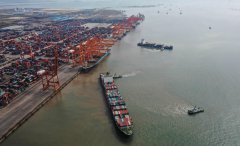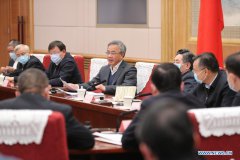US tribes see hope for clean water in infrastructure bill
The massive infrastructure bill signed earlier this year promises to bring change to Native American tribes that lack clean water or indoor plumbing through the largest single infusion of money into Indian Country
December 23, 2021, 11:25 PM
7 min read
Share to FacebookShare to TwitterEmail this articleDan Martinez, emergency manager for the Confederated Tribes of Warm Springs, pauses in a classroom used to store donated water on Tuesday, Dec. 7, 2021, in, Warm Springs, Ore. In Oregon, tribal officials have handed out about 3 million gallons (11 million liters) of water — almost all of it donated — from a decommissioned elementary school on the reservation. (AP Photo/Nathan Howard)
WARM SPRINGS, Ore. -- Erland Suppah Jr. doesn’t trust what comes out of his faucet.
Each week, Suppah and his girlfriend haul a half-dozen large jugs of water from a distribution center run by the Confederated Tribes of Warm Springs to their apartment for everything from drinking to cooking to brushing their teeth for their family of five. It’s the only way they feel safe after countless boil-water notices and weekslong shutoffs on a reservation struggling with bursting pipes, failing pressure valves and a geriatric water treatment plant.
“About the only thing this water is good for is cleaning my floor and flushing down the toilet,” Suppah said of the tap water in the community 100 miles (160 kilometers) southeast of Portland. “That’s it.”
In other, more remote tribal communities across the country, running water and indoor plumbing have never been a reality.
Now, there’s a glimmer of hope in the form of a massive infrastructure bill signed last month that White House officials say represents the largest single infusion of money into Indian Country. It includes $3.5 billion for the federal Indian Health Service, which provides health care to more than 2 million Native Americans and Alaska Natives, plus pots of money through other federal agencies for water projects.
Tribal leaders say the funding, while welcome, won’t make up for decades of neglect from the U.S. government, which has a responsibility to tribes under treaties and other acts to ensure access to clean water. A list of sanitation deficiencies kept by the Indian Health Service has more than 1,500 projects, including wells, septic systems, water storage tanks and pipelines. Some projects would address water contamination from uranium or arsenic.
About 3,300 homes in more than 30 rural Alaska communities lack indoor plumbing, according to a 2020 report. On the Navajo Nation, the largest Native American reservation, about one-third of the 175,000 residents are without running water.
Residents in these places haul water for basic tasks such as washing and cooking, sometimes driving long distances to reach communal water stations. Instead of indoor bathrooms, many use outhouses or lined pails called “honey buckets” that they drag outside to empty. Some shower or do laundry at community sites known as “washeterias,” but the equipment can be unreliable and the fees expensive.
“You look at two billionaires competing to fly into outer space, yet we’re trying to get basic necessities in villages of interior Alaska,” said PJ Simon, a former chairman of an Alaska Native nonprofit corporation called the Tanana Chiefs Conference.
Many more tribal communities have indoor plumbing but woefully inadequate facilities and delivery systems riddled with aging pipes.
The coronavirus pandemic, which disproportionately hit Indian Country, further underscored the stark disparities in access to running water and sewage systems.
In Warm Springs, the water crisis has overlapped with COVID-19.
“During a worldwide pandemic, we’ve had a boil-water notice. How are we supposed to wash our hands? How are we supposed to sanitize our homes to disinfect, to keep our community members safe? How can we do that ... when our water isn’t even clean?” said Dorothea Thurby, who oversees the distribution of free water to tribal members and food boxes to those who are quarantined.
A 2019 report by a pair of nonprofit groups, U.S. Water Alliance and Dig Deep, found Native American homes are 19 times more likely than white households to lack full plumbing. And federal officials note tribal members without indoor toilets or running water are at increased risk of respiratory tract, skin and gastrointestinal infections.









